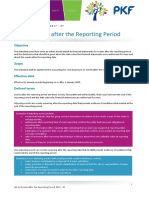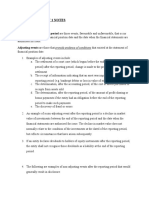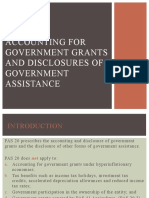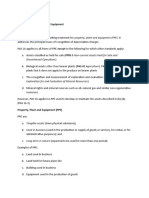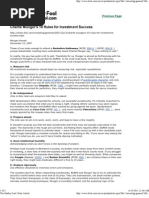0 ratings0% found this document useful (0 votes)
58 viewsPas 10
PAS 10 provides guidance on accounting for events that occur after the end of a reporting period but before financial statements are authorized for issue. It distinguishes between adjusting events, which provide evidence of conditions that existed at the end of the reporting period and require adjustments to amounts recognized in financial statements, and non-adjusting events, which provide evidence that arose after the reporting period and do not require adjustments but need to be disclosed if material. Examples of adjusting events include legal cases confirming liabilities, asset impairments identified, and profit-sharing amounts determined after the period end. Non-adjusting events can include changes in fair values, casualty losses, new commitments, and major business changes.
Uploaded by
Justine VeralloCopyright
© © All Rights Reserved
Available Formats
Download as PPTX, PDF, TXT or read online on Scribd
0 ratings0% found this document useful (0 votes)
58 viewsPas 10
PAS 10 provides guidance on accounting for events that occur after the end of a reporting period but before financial statements are authorized for issue. It distinguishes between adjusting events, which provide evidence of conditions that existed at the end of the reporting period and require adjustments to amounts recognized in financial statements, and non-adjusting events, which provide evidence that arose after the reporting period and do not require adjustments but need to be disclosed if material. Examples of adjusting events include legal cases confirming liabilities, asset impairments identified, and profit-sharing amounts determined after the period end. Non-adjusting events can include changes in fair values, casualty losses, new commitments, and major business changes.
Uploaded by
Justine VeralloCopyright
© © All Rights Reserved
Available Formats
Download as PPTX, PDF, TXT or read online on Scribd
You are on page 1/ 10
PAS 10
Events After the
Reporting Period
Introduction
PAS 10 prescribes the accounting for, and
disclosures of, events after the reporting
period, including disclosures regarding the
date when the financial statements were
authorized for issue.
Events after the Reporting Period
Events after the reporting period are “those events, favorable and
unfavorable, that occur between the end of the reporting period and
the date when the financial statements are authorized for issue”. (PAS
10.3)
For example, Entity A’s reporting period ends on December 31, 20x1
and its financial statements are authorized for issue on March 31,
20x2. Events after the reporting period are those events that occur
within January 1, 20x2 to March 31, 20x2.
⮚ The date of authorization of the financial statements is the date
when management authorizes the financial statements for issue
regardless of whether such authorization is final or subject to
further approval.
Two types of events after the reporting period
1. Adjusting events after the reporting period – are
events that provide evidence of conditions that
existed at the end of the reporting period.
2. Non-adjusting events after the reporting period
– are events that are indicative of conditions that
arose after the reporting period.
Adjusting events after the reporting period
Adjusting events, as the name suggests, require adjustments of
amounts in the financial statements. Examples of adjusting events:
a. The settlement after the reporting period of a court case that
confirms that the entity has a present obligation at the end of the
reporting period.
b. The receipt of information after the reporting period indicating
that an asset was impaired at the end of reporting period. For
example:
i. The bankruptcy of a customer that occurs after the reporting period
may indicate that carrying amount of a trade receivable at the end of
reporting period is impaired.
ii. The sale of inventories after the reporting period may give evidence
to their net realizable value at the end of reporting period.
c. The determination after the reporting period of the cost
of asset purchased, or the proceeds from asset sold,
before the end of reporting period.
d. The determination after the reporting period of the
amount of profit-sharing or bonus payments, if the entity
had a present legal or constructive obligation at the end
of reporting period to make such payments.
e. The discovery of fraud or errors that indicate that the
financial statements are incorrect. (PAS 10.9)
Non-adjusting events after the reporting period
Non-adjusting events do not require adjustments of amounts in the
financial statements. However, they are disclosed if they are material.
Examples of non-adjusting events:
a. Changes in fair values, foreign exchange rates, interest rates or
market prices after the reporting period.
b. Casualty losses (e.g., fire, storm, or earthquake) occurring after the
reporting period but before the financial statements were
authorized for issue.
c. Litigation arising solely from events occurring after the reporting
period.
d. Significant commitments or contingent liabilities entered after the
reporting period, e.g., significant guarantees.
e. Major ordinary share transactions and potential ordinary share
transactions after the reporting period.
f. Major business combination after the reporting period.
g. Announcing, or commencing the implementation of, a major
restructuring after the reporting period.
h. Announcing a plan to discontinue an operation after the reporting
period.
i. Change in tax rate enacted after the reporting period.
j. Declaration of dividends after the reporting period. (PAS 10.9)
Dividends
Dividends declared after the reporting period
are not recognized as liability at the end of the
reporting period because no present obligation
exists at the end of reporting period.
Going Concern
PAS 10 prohibits the preparation of financial
statements on a going concern basis if
management determines after the reporting
period either that it intends to liquidate the
entity or to cease trading, or that it has no
realistic alternative but to do so.
You might also like
- Realizable Value at The End of Reporting PeriodNo ratings yetRealizable Value at The End of Reporting Period3 pages
- Chapter 25 IAS 10 Events After The Reporting PeriodNo ratings yetChapter 25 IAS 10 Events After The Reporting Period4 pages
- IAS 10 Events After The Reporting Period Lecture Notes (Student Copy)No ratings yetIAS 10 Events After The Reporting Period Lecture Notes (Student Copy)3 pages
- C12 - PAS 10 Events After The Reporting Period100% (1)C12 - PAS 10 Events After The Reporting Period3 pages
- Lecture 10. Events After The Reporting Period 061805No ratings yetLecture 10. Events After The Reporting Period 06180515 pages
- Chapter 12 - Events After The Reporting PeriodNo ratings yetChapter 12 - Events After The Reporting Period3 pages
- Tutorial Event After Reporting Period Week 7No ratings yetTutorial Event After Reporting Period Week 710 pages
- Events After The Reporting Period: By:-Yohannes NegatuNo ratings yetEvents After The Reporting Period: By:-Yohannes Negatu13 pages
- PAS 10 Events After The Reporting PeriodNo ratings yetPAS 10 Events After The Reporting Period23 pages
- Ias 10 Events After The Reporting Period SummaryNo ratings yetIas 10 Events After The Reporting Period Summary2 pages
- Ias-10: Events After The Reporting Period: ScopeNo ratings yetIas-10: Events After The Reporting Period: Scope3 pages
- IAS 10 Events After The Reporting Period-A Closer LookNo ratings yetIAS 10 Events After The Reporting Period-A Closer Look7 pages
- Chapter 21 - Events After The Reporting PeriodNo ratings yetChapter 21 - Events After The Reporting Period2 pages
- Chapter 13 Events After The Reporting PeriodNo ratings yetChapter 13 Events After The Reporting Period2 pages
- Chapter 13 Events After The Reporting PeriodNo ratings yetChapter 13 Events After The Reporting Period2 pages
- Chapter 12 Events After The Reporting Period PDF0% (1)Chapter 12 Events After The Reporting Period PDF4 pages
- Events After The Reporting Period (MFRS)No ratings yetEvents After The Reporting Period (MFRS)14 pages
- Cfas Chapeter Exam Events After Reporting Period100% (1)Cfas Chapeter Exam Events After Reporting Period2 pages
- Name: Nouman Qayyum ROLL NO. L1F18BSCM0003 Subject: Coroporate Reporting Presented To: Prof. Muhammaf ShamasNo ratings yetName: Nouman Qayyum ROLL NO. L1F18BSCM0003 Subject: Coroporate Reporting Presented To: Prof. Muhammaf Shamas11 pages
- Module 017 Week006-Finacct3 Notes To The Financial StatementsNo ratings yetModule 017 Week006-Finacct3 Notes To The Financial Statements5 pages
- PAS 10 Events After The Reporting PeriodNo ratings yetPAS 10 Events After The Reporting Period2 pages
- Psak 8 (Events After The Reporting Period)No ratings yetPsak 8 (Events After The Reporting Period)1 page
- Chapter 12 Events After The Reporting Period PAS10No ratings yetChapter 12 Events After The Reporting Period PAS103 pages
- Review Materials: Prepared By: Junior Philippine Institute of Accountants UC-Banilad Chapter F.Y. 2019-2020No ratings yetReview Materials: Prepared By: Junior Philippine Institute of Accountants UC-Banilad Chapter F.Y. 2019-202023 pages
- Accounting Standard 4: Guided By: Dr. Narshing Subash Giri (Sir)No ratings yetAccounting Standard 4: Guided By: Dr. Narshing Subash Giri (Sir)12 pages
- Events After The Reporting Period (IAS 10)No ratings yetEvents After The Reporting Period (IAS 10)16 pages
- Chapter 18 - Gripping IFRS ICAP 2008 (Solution of Graded Questions)No ratings yetChapter 18 - Gripping IFRS ICAP 2008 (Solution of Graded Questions)10 pages
- Pas 10 Events After The Balance Sheet DateNo ratings yetPas 10 Events After The Balance Sheet Date2 pages
- ACT204 S12017 Week 11 Tutorial SolutionsNo ratings yetACT204 S12017 Week 11 Tutorial Solutions4 pages
- Accounting Terminology: QuickStudy Laminated Reference GuideFrom EverandAccounting Terminology: QuickStudy Laminated Reference GuideNo ratings yet
- Share-Based Payment: Except The FollowingNo ratings yetShare-Based Payment: Except The Following9 pages
- Significant Influence Is "The Power To Participate in The Financial and Operating Policy Decisions of TheNo ratings yetSignificant Influence Is "The Power To Participate in The Financial and Operating Policy Decisions of The5 pages
- Contributory, Funded (Managed by A Trustee) or Unfunded (Managed by The Employer), and Defined Contribution Plan or Defined Benefit PlanNo ratings yetContributory, Funded (Managed by A Trustee) or Unfunded (Managed by The Employer), and Defined Contribution Plan or Defined Benefit Plan5 pages
- Prior Period Errors. These Are Intended To Enhance The Relevance, Reliability and Comparability of TheNo ratings yetPrior Period Errors. These Are Intended To Enhance The Relevance, Reliability and Comparability of The4 pages
- Investment Property: Investment Property - Is Land And/or Building Held To Earn Rentals or Capital Appreciation or Both100% (1)Investment Property: Investment Property - Is Land And/or Building Held To Earn Rentals or Capital Appreciation or Both9 pages
- "Full" Pfrss Refer To The Standards That We Had DiscussedNo ratings yet"Full" Pfrss Refer To The Standards That We Had Discussed7 pages
- Two Ways of Conducting Foreign ActivitiesNo ratings yetTwo Ways of Conducting Foreign Activities7 pages
- Borrowing Costs That Are Directly Attributable To The Acquisition, Construction orNo ratings yetBorrowing Costs That Are Directly Attributable To The Acquisition, Construction or4 pages
- Separate Financial Statements Are Those Presented in Addition ToNo ratings yetSeparate Financial Statements Are Those Presented in Addition To2 pages
- Current at The End of The Reporting Period. Comparative Figures For Prior Period(s) Shall Also Be RestatedNo ratings yetCurrent at The End of The Reporting Period. Comparative Figures For Prior Period(s) Shall Also Be Restated3 pages
- Property, Plant and Equipment: Discontinued Operations)No ratings yetProperty, Plant and Equipment: Discontinued Operations)8 pages
- Advantage and Disadvantages of Business OrganizationNo ratings yetAdvantage and Disadvantages of Business Organization3 pages
- CAPM - Theory, Advantages, and Disadvantages - F9 Financial Management - ACCA Qualification - StudentsNo ratings yetCAPM - Theory, Advantages, and Disadvantages - F9 Financial Management - ACCA Qualification - Students4 pages
- The Hindu Newspaper May 2023 Synopsis For UPSC Prelims 2024No ratings yetThe Hindu Newspaper May 2023 Synopsis For UPSC Prelims 20243 pages
- Capgemini - 2024-02-20 - 2023 Consolidated Financial StatementsNo ratings yetCapgemini - 2024-02-20 - 2023 Consolidated Financial Statements67 pages
- JD 2025 Summer Internship - CIB Research and Analytics BankingNo ratings yetJD 2025 Summer Internship - CIB Research and Analytics Banking2 pages
- All Merged Final KRD Cfal1 Quick Revision 2023No ratings yetAll Merged Final KRD Cfal1 Quick Revision 2023289 pages
- Project ON Investment Options in India: Sakshi Singhal Year Section - A ROLL - NO. - 3001100% (1)Project ON Investment Options in India: Sakshi Singhal Year Section - A ROLL - NO. - 300134 pages
- Financial Performance Analysis of Adidas AG: January 2016No ratings yetFinancial Performance Analysis of Adidas AG: January 201610 pages
- Chapter 11 Capital Budgeting Cash Flows: Principles of Managerial Finance, 14e (Gitman/Zutter)No ratings yetChapter 11 Capital Budgeting Cash Flows: Principles of Managerial Finance, 14e (Gitman/Zutter)18 pages
- II - Audit of The Revenue and Receipt CycleNo ratings yetII - Audit of The Revenue and Receipt Cycle13 pages
- Developing A Childcare Center Business Plan: 1. Cover Sheet - Summary100% (1)Developing A Childcare Center Business Plan: 1. Cover Sheet - Summary3 pages
- ENGG ECONOMY WEEK 5 ANNUITIES & CAPITALIZED COSTNo ratings yetENGG ECONOMY WEEK 5 ANNUITIES & CAPITALIZED COST82 pages
- Financial Analysis General Banking ActivitiesNo ratings yetFinancial Analysis General Banking Activities56 pages
- Aberdeen Emerging Markets Telecom & Infrastructure Fund, Inc. (ETF)No ratings yetAberdeen Emerging Markets Telecom & Infrastructure Fund, Inc. (ETF)28 pages
- Chapter 25 IAS 10 Events After The Reporting PeriodChapter 25 IAS 10 Events After The Reporting Period
- IAS 10 Events After The Reporting Period Lecture Notes (Student Copy)IAS 10 Events After The Reporting Period Lecture Notes (Student Copy)
- Lecture 10. Events After The Reporting Period 061805Lecture 10. Events After The Reporting Period 061805
- Events After The Reporting Period: By:-Yohannes NegatuEvents After The Reporting Period: By:-Yohannes Negatu
- IAS 10 Events After The Reporting Period-A Closer LookIAS 10 Events After The Reporting Period-A Closer Look
- Name: Nouman Qayyum ROLL NO. L1F18BSCM0003 Subject: Coroporate Reporting Presented To: Prof. Muhammaf ShamasName: Nouman Qayyum ROLL NO. L1F18BSCM0003 Subject: Coroporate Reporting Presented To: Prof. Muhammaf Shamas
- Module 017 Week006-Finacct3 Notes To The Financial StatementsModule 017 Week006-Finacct3 Notes To The Financial Statements
- Chapter 12 Events After The Reporting Period PAS10Chapter 12 Events After The Reporting Period PAS10
- Review Materials: Prepared By: Junior Philippine Institute of Accountants UC-Banilad Chapter F.Y. 2019-2020Review Materials: Prepared By: Junior Philippine Institute of Accountants UC-Banilad Chapter F.Y. 2019-2020
- Accounting Standard 4: Guided By: Dr. Narshing Subash Giri (Sir)Accounting Standard 4: Guided By: Dr. Narshing Subash Giri (Sir)
- Chapter 18 - Gripping IFRS ICAP 2008 (Solution of Graded Questions)Chapter 18 - Gripping IFRS ICAP 2008 (Solution of Graded Questions)
- Accounting Terminology: QuickStudy Laminated Reference GuideFrom EverandAccounting Terminology: QuickStudy Laminated Reference Guide
- 1040 Exam Prep Module III: Items Excluded from Gross IncomeFrom Everand1040 Exam Prep Module III: Items Excluded from Gross Income
- Significant Influence Is "The Power To Participate in The Financial and Operating Policy Decisions of TheSignificant Influence Is "The Power To Participate in The Financial and Operating Policy Decisions of The
- Contributory, Funded (Managed by A Trustee) or Unfunded (Managed by The Employer), and Defined Contribution Plan or Defined Benefit PlanContributory, Funded (Managed by A Trustee) or Unfunded (Managed by The Employer), and Defined Contribution Plan or Defined Benefit Plan
- Prior Period Errors. These Are Intended To Enhance The Relevance, Reliability and Comparability of ThePrior Period Errors. These Are Intended To Enhance The Relevance, Reliability and Comparability of The
- Investment Property: Investment Property - Is Land And/or Building Held To Earn Rentals or Capital Appreciation or BothInvestment Property: Investment Property - Is Land And/or Building Held To Earn Rentals or Capital Appreciation or Both
- "Full" Pfrss Refer To The Standards That We Had Discussed"Full" Pfrss Refer To The Standards That We Had Discussed
- Borrowing Costs That Are Directly Attributable To The Acquisition, Construction orBorrowing Costs That Are Directly Attributable To The Acquisition, Construction or
- Separate Financial Statements Are Those Presented in Addition ToSeparate Financial Statements Are Those Presented in Addition To
- Current at The End of The Reporting Period. Comparative Figures For Prior Period(s) Shall Also Be RestatedCurrent at The End of The Reporting Period. Comparative Figures For Prior Period(s) Shall Also Be Restated
- Property, Plant and Equipment: Discontinued Operations)Property, Plant and Equipment: Discontinued Operations)
- Advantage and Disadvantages of Business OrganizationAdvantage and Disadvantages of Business Organization
- CAPM - Theory, Advantages, and Disadvantages - F9 Financial Management - ACCA Qualification - StudentsCAPM - Theory, Advantages, and Disadvantages - F9 Financial Management - ACCA Qualification - Students
- The Hindu Newspaper May 2023 Synopsis For UPSC Prelims 2024The Hindu Newspaper May 2023 Synopsis For UPSC Prelims 2024
- Capgemini - 2024-02-20 - 2023 Consolidated Financial StatementsCapgemini - 2024-02-20 - 2023 Consolidated Financial Statements
- JD 2025 Summer Internship - CIB Research and Analytics BankingJD 2025 Summer Internship - CIB Research and Analytics Banking
- Project ON Investment Options in India: Sakshi Singhal Year Section - A ROLL - NO. - 3001Project ON Investment Options in India: Sakshi Singhal Year Section - A ROLL - NO. - 3001
- Financial Performance Analysis of Adidas AG: January 2016Financial Performance Analysis of Adidas AG: January 2016
- Chapter 11 Capital Budgeting Cash Flows: Principles of Managerial Finance, 14e (Gitman/Zutter)Chapter 11 Capital Budgeting Cash Flows: Principles of Managerial Finance, 14e (Gitman/Zutter)
- Developing A Childcare Center Business Plan: 1. Cover Sheet - SummaryDeveloping A Childcare Center Business Plan: 1. Cover Sheet - Summary
- Aberdeen Emerging Markets Telecom & Infrastructure Fund, Inc. (ETF)Aberdeen Emerging Markets Telecom & Infrastructure Fund, Inc. (ETF)





















